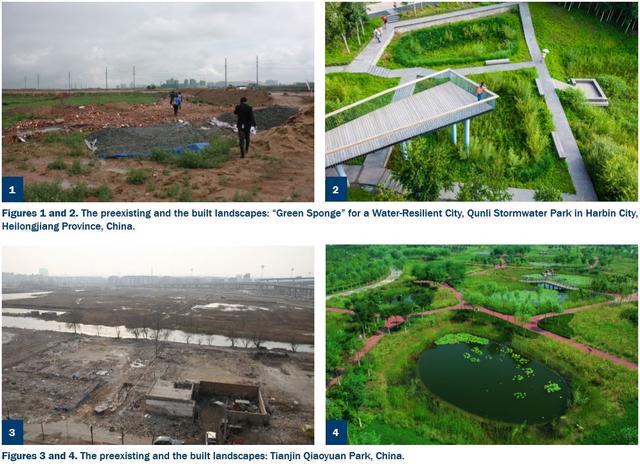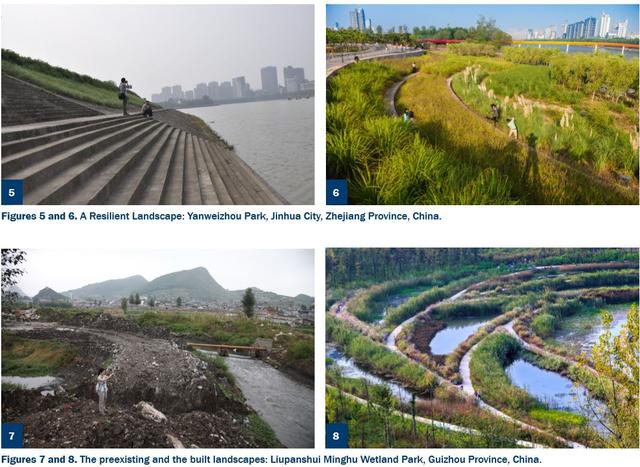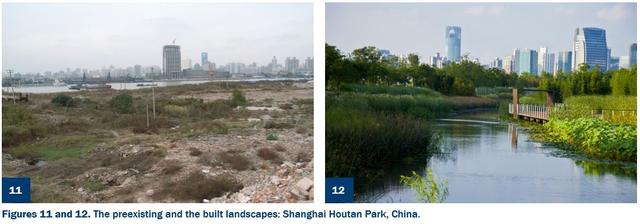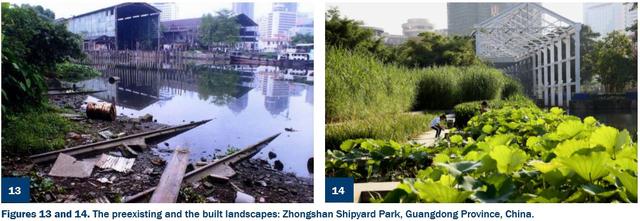
地址:北京市海淀區(qū)中關(guān)村北大街100號(北樓)北京大學(xué)建筑與景觀設(shè)計學(xué)院一層 Email:info@landscape.cn
Copyright ? 2013-2022 景觀中國(www.cncwe.org)版權(quán)所有 京ICP備05068035號
 京公海網(wǎng)安備 110108000058號
京公海網(wǎng)安備 110108000058號
This essay argues that the gray infrastructures made of steel and concrete, which we built to connect our physical world, are shallow or even fake constructs that are destroying the real and deep connections between human beings and nature, and among various natural processes and flows. The alternative is green infrastructure, or ecological infrastructure, the construction of which can be inspired by the ancient wisdoms of peasantry. For the past twenty years, the author has tried to revive some of these peasantry wisdoms, and combine them with modern sciences and technologies to solve some of the most annoying problems in today’s urban environment, particularly around water. The solutions are simple, inexpensive, and beautiful and have been applied on a massive and extensive scale in over two hundred cities in China and beyond.
Gray Infrastructure and Broken Connections
Some people may think that our world, through our built infrastructure, is more connected digitally and physically than ever before: we have Facebook and WeChat on the one hand, and ubiquitous highways and pipelines on the other. But actually the opposite is true. More than ever we are disconnected from the communities we belong to, and we have alienated ourselves from our neighbors and from those we love.
Physically, the landscapes that we inhabit are visibly interconnected: motorways connect urban and rural settlements; power lines that transport energy connect power stations to individual families; pipelines that drain waste water connect our toilets to sewage treatment plants; aqueducts that transport drinking water connect reservoirs to our kitchens; airlines that transport food connect the farm in the southern hemisphere to the refrigerators in the north; trucks that carry fertilizers and herbicides on the highways connect city factories in the east with the peasants who farm in the rice paddies in the mountainous west. We have created a connected world, but these connections are false: the landscape matrix and its invisible processes are fragmented and disconnected. The movement and cycles of water, nutrients, food, energy, species, and people are broken. The interconnected relationship between air, water, soil, nutrient, species, and people is being interrupted, and in a harmful way, more than ever before.
Let me offer an example concerning water. Over 75 percent of the surface water in China is polluted; 50 percent of China’s more than 660 cities are facing floods and urban inundation; and over 60 percent of China’s cities do not have enough water for drinking and for other uses. The groundwater table in the North China Plain drops over one meter each year; and over 50 percent of the wetland habitats have been lost in the past fifty years. All these water-cycle related issues that impact our cities and our landscapes are actually interconnected, but the conventional infrastructural solutions designed to solve these problems are fragmented, isolated, and single-minded: We build water treatment plants to remove the nutrients that could be used in fertilizers for farming; billions of dollars are spent yearly on the construction of concrete dikes, dams, and pipes to control floods and stormwaters, but these structures eventually produce fiercer droughts, declines in groundwater levels, and habitat loss; a thousand-mile-long aqueduct built to divert water from Southern to Northern China caused serious damage to the ecosystem in the lower and middle reaches of the Yangtze River; ornamental gardens and landscapes as well as agricultural fields are over-fertilized and all those nutrients flush into the water system, polluting the rivers and the lakes. And again, the conventional solution is single-minded–build expensive water treatment plants that need huge amounts of energy (mainly from coal burning) to operate, which in turn create more air pollution.
An alternative solution might be the construction of green infrastructure, or ecological infrastructure, which creates a deep and true connection between man and nature and among various natural processes and flows.
The Ancient Wisdom of Peasantry
The connections between peasants and their farmlands illustrate the timeless interdependence of human culture and nature. One alternative to rebuilding the deep connections between human beings and nature and among various natural processes comes from the wisdom of peasantry, of field-making, irrigating, fertilizing, growing, and harvesting, which have transformed landscapes on a large scale and sustained humanity for thousands of years.
One category of peasantry wisdom is the making of fields through a cut-and-fill action. The peasant’s approach to cut and fill is one integrated action, meaning the earthworks created for farming happen on-site, with minimum costs for labor and minimum transportation of material to or from the site. It has, therefore, a minimum impact on the natural processes and patterns in the region. This tactic has been implemented by peasants in almost all parts of the world as a way to transform their otherwise unsuitable environments into productive and livable landscapes.
The second category of ancient peasantry wisdom lies in managing water and irrigating the fields. Modern methods of irrigation used in both farming and landscaping are represented by a system of pipes and pumps that is nearly invisible. It doesn’t relate to surrounding terrain and available water resources. The peasant’s approach to irrigation is deeply rooted in natural processes and patterns. Thousands of years of farming experience have made irrigation one of the most sophisticated techniques in agricultural societies. The use of gravity to irrigate the field requires precise knowledge, and the harmony between nature and subtle human intervention can turn such a serious science into an art form, an interactive medium of community building, and even a spiritual force.
The third category of peasantry wisdom is fertilizing. It is a magical component of traditional farming and a critical link, closing the circle by reusing the materials of human living. All wastes from humans and domestic animals as well as vegetative materials are recycled into fertilizers. Such a nutrient cycle is broken in our urbanized and industrialized settings. What peasants call fertilizers are today defined as “pollutants” in our lakes and rivers.
The fourth category of peasantry wisdom is growing and harvesting. Unlike planting and pruning in gardening to create a pleasant ornamental form, the peasant’s approach to planting is focused on productivity. Planting begins with the sowing of seeds, and the management process follows nature’s rhythm as a strategy of adaptation to the surrounding climate and conditions. Again, the self-sufficient nature of ancient agricultural economies requires each household to grow diverse crops, including grains, vegetables, fibers, medicines, fruits, timber, fuel, and even fertilizer proportionately to the seasonal needs of the family, and within the limits of nature and human capabilities. The meaning of harvest goes far beyond the production of foods and products. Harvests are productive in terms of their capacity to enrich the soil, purify the water, and make the land healthy. In other words, the peasant’s fields are net producers instead of net consumers of energy and resources.
This is not to say that one should give up the comfort of urbanization and go back to a peasant’s primitive life. These essential features of peasantry illuminate the underlying basis for rebuilding the connections between nature and human desires, balancing natural processes and cultural intervention, and help us to reclaim the harmonious relationships between human beings and nature.
Revival of the Ancient Wisdom to Create an Alternative Infrastructure
Imagine what our cities would look like if we did not drain the rainwater away through pipes and pumps, but instead used the ancient wisdom of peasantry in field-making to create a green sponge in the city that retains the rain water, creating diverse habitats and recharging the aquifer. In this way, the green spaces in the city become an ecological infrastructure that provides multiple ecosystem services that regulate the urban environment to be resilient to flood or drought, allowing clean water and food to be produced right in the middle of the city. Biodiversity would be enhanced dramatically; urban residents would have a green network for jogging, commuting, and relaxing; and real estate values would increase because of the beauty of, and access to, nature! That is what we have tried to do in many cities in the past twenty years: to transform the city into a sponge city (see figures 1–4).

Imagine what our cities would look like if we abandon the high and rigid concrete flood walls and instead revive the ancient wisdom of peasantry and create vegetated terraces at the river banks that adapt to the up and down of the water flow. Ecofriendly solutions like ponds and low weirs are designed to slow down the flow of water and let nature take time to nourish itself, so that diverse habitats can be created that enrich vegetation and wild life, allowing nutrients to be absorbed by the biological processes! That is what we have done to transform the mother rivers in many Chinese cities (see figures 5–10).

Imagine what our cities would look like if the nutrient-rich (eutrophic) river and lake water could be cleansed through the landscape as a living system, in the way that peasants have recycled organic waste, instead of using expensive sewage plants to remove the nutrients. We could produce clean water and nourish the lush vegetation. Native biodiversity could be improved. We could turn recreational spaces into urban parks and, in this way, urban parks could become producers instead of consumers of energy and water. That is what we have done to transform the landscape into a living system that mediates polluted water (see figures 11 and 12).

Imagine what our cities would look like if the brown fields of industrial sites are recovered by the processes of nature, where the ancient wisdom of the pond-and-dyke system is adapted to create a terrain that collects rainwater (instead of draining it away through pipes) and initiates the evolution of a plant community, remediating the contaminated soil during this process. At the same time, the industrial structures are preserved as sites of cultural heritage in the city. A unique landscape is created, featuring dynamic native vegetation and a touchable memory of the past, which attract urban residents because of its beauty as well as the diverse wild life that it maintains in the middle of the city. This is what we have done in several industrial cities (see figures 13 and 14).

Imagine what our cities would look like if we turn some of the urban land back into productive landscapes instead of into expensive lawns or ornamental gardens, so that the long-distance transportation of food can be reduced. Let the rice, sunflowers, beans, and vegetables be grown in the city, let the sun and moon tell the time for sowing and harvesting, let the seasonal change be noticed by the urban residents, let the process of food growing be known to the young, and let the beauty of crops be appreciated! This will not only make our city more productive and sustainable, but nourish a new aesthetic and a new ethics of land and food. This is what we have done in some Chinese cites (see figures 15 and 16).

? 2017 by Kongjian
Kongjian Yu is Founder and Dean of the College of Architecture and Landscape and Cheung Kong Scholar Chair Professor at Peking University, and Founder and President of Turenscape. He was elected a member of the American Academy in 2016.
文章來源:美國藝術(shù)與科學(xué)院院刊
原文鏈接:https://www.amacad.org/content/publications/pubContent.aspx?d=32912
